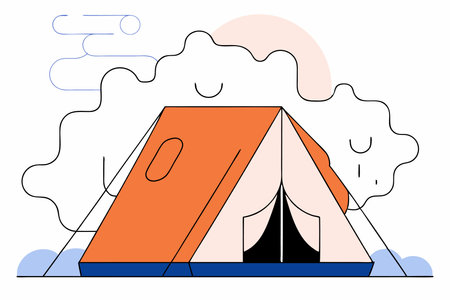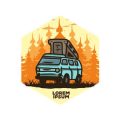1. Choosing the Right Winter Campsite
When it comes to solo winter camping, where you set up your tent can make or break your experience. Cold temperatures, snow, and unpredictable weather mean that choosing a safe and sheltered campsite is more important than ever. Here are some tips to help you find the right spot.
Look for Natural Wind Protection
Wind chill can make cold conditions even more brutal. Try to find a spot thats naturally shielded from the wind—think behind a stand of trees, near rock formations, or in small hollows (but not deep valleys where cold air settles). Avoid setting up camp on ridgelines or open plains where wind exposure is high.
Avoid Avalanche-Prone Areas
If youre camping in mountainous terrain, its critical to recognize and avoid avalanche zones. Slopes between 30° and 45° are especially dangerous after fresh snowfall. Stay below treeline when possible, and always check local avalanche forecasts before heading out. Heres a quick reference guide:
| Slope Angle | Avalanche Risk |
|---|---|
| < 25° | Low risk |
| 30° – 45° | High risk (avoid) |
| > 50° | Low risk but unstable footing |
Understand the Terrain
The landscape changes drastically in winter. What looks like flat ground might actually be a frozen lake or buried creek. Use a map and GPS to confirm your location and avoid areas prone to flooding or thin ice. Set up on firm, level ground thats elevated enough to stay dry but not so steep that you’ll slide around in your sleep.
Shelter from Snow Accumulation
Avoid pitching your tent directly under heavy-laden tree branches or cliffs with overhangs—snow can fall without warning. Also steer clear of open slopes that could accumulate drifting snow overnight.
Campsite Checklist for Solo Winter Camping
- Sheltered from wind (trees, rocks, natural dips)
- Away from avalanche-prone slopes (check angles & forecasts)
- No risk of falling snow or ice above your tent
- Avoid frozen lakes, rivers, or creeks as base sites
- Slightly elevated ground to prevent water pooling if temps rise
Selecting the right campsite isnt just about comfort—its about safety. Taking time to evaluate your surroundings can make your solo winter adventure both enjoyable and secure.
2. Essential Gear for Cold Weather Survival
When youre heading out on a solo winter camping trip, your gear can make or break your adventure. Staying warm, dry, and safe is the top priority, and that means packing smart with equipment designed to handle freezing temperatures and unpredictable conditions. Here’s a breakdown of the must-have gear you’ll need to not just survive, but thrive in the cold.
Four-Season Tent
A four-season tent is built to stand up against strong winds, heavy snow, and frigid temps. Unlike three-season tents, these are designed with sturdier poles, less mesh (to retain heat), and steeper walls to prevent snow buildup. Look for one that has a vestibule for storing gear and double-wall construction for extra insulation.
Insulation Layers
Dressing in layers helps regulate body temperature and keeps you dry from sweat. The key is using moisture-wicking, insulating, and windproof materials in the right order:
| Layer | Purpose | Recommended Materials |
|---|---|---|
| Base Layer | Wicks moisture away from skin | Merino wool or synthetic fabrics |
| Mid Layer | Traps body heat | Fleece or down jacket |
| Outer Layer | Protects against wind/snow | Waterproof breathable shell |
Winter Sleeping System
Your sleeping setup needs to keep you warm even when temperatures drop well below freezing. This includes:
- Sleeping Bag: Choose a bag rated at least 10°F lower than the expected temps. Down offers great insulation but make sure it stays dry.
- Sleeping Pad: Use an insulated pad with a high R-value (at least 4.5). Combining two pads (foam + inflatable) works well too.
- Liner: A thermal liner can add up to 15°F of warmth to your bag.
Backup Heat Sources
Even with all the right gear, having backup heat sources gives peace of mind during extreme cold. Some options include:
- Chemical Hand/Body Warmers: Great for quick warmth inside gloves or sleeping bags.
- Candle Lanterns: Provide light and minimal heat inside your tent (ventilation required).
- Portable Propane Heaters: Use cautiously and only with proper ventilation to avoid carbon monoxide risks.
Other Key Gear Essentials
- Stove & Fuel: Liquid fuel stoves perform better than canisters in sub-zero temps.
- Snow Shovel: Useful for digging out tent sites or creating a wind barrier.
- Trekking Poles with Snow Baskets: Help maintain balance on snowy terrain.
- Headlamp with Extra Batteries: Winter nights are long—reliable lighting is crucial.
Packing the right gear is your first line of defense against the harsh elements of winter. Each item plays a role in keeping you safe and comfortable when youre out there on your own in the cold wilderness.
![]()
3. Staying Warm and Dry
When youre solo winter camping, staying warm and dry isnt just about comfort — its about survival. The cold can sneak up on you fast, especially when youre alone. Here’s how to stay cozy, dry, and safe with smart layering, moisture control, wind protection, and some tried-and-true heating tricks.
Layer Like a Pro
Proper layering helps regulate your body temperature while keeping sweat away from your skin. Heres a simple breakdown:
| Layer | Purpose | Examples |
|---|---|---|
| Base Layer | Wicks moisture away from your skin | Merino wool or synthetic long underwear |
| Mid Layer | Insulates and retains body heat | Fleece jacket or down sweater |
| Outer Layer (Shell) | Protects from wind, snow, and rain | Waterproof/breathable jacket and pants |
Moisture Management Matters
Sweat is your enemy in the cold. Even if youre bundled up right, damp clothes will chill you fast. If youre hiking to your campsite or doing chores, try to remove layers before you start sweating too much. Always change out of wet clothes as soon as possible — especially socks and base layers.
Build a Windbreak for Shelter
Wind steals heat quickly, so setting up camp behind natural barriers like rock formations or trees can make a big difference. If there’s no natural protection around, build your own windbreak using snow walls or stacked gear like sleds or tarps anchored with snow stakes.
Use Hot Water Bottles for Extra Warmth
A hot water bottle tucked into your sleeping bag can keep you warm for hours. Boil water before bed, pour it into a durable Nalgene-style bottle (make sure it’s leak-proof!), and wrap it in a sock or cloth before placing it at your feet or between your thighs to warm key arteries.
Fire Techniques That Work Solo
If fire is allowed at your location, it’s a great way to stay warm and boost morale. Use these tips for a safe and effective solo campfire:
- Gather plenty of dry wood before dark.
- Create a fire reflector: Stack logs or rocks behind the fire to reflect heat toward your shelter.
- Keep fires small but steady: Large fires burn fuel fast and are harder to control solo.
- Always have water or snow nearby: Safety first — never leave a fire unattended.
With the right strategies, staying warm and dry during solo winter camping is totally doable — and it makes the experience that much more enjoyable.
4. Solo Safety in Remote Areas
Heading out alone into the winter wilderness can be an incredible experience, but safety should always come first—especially when youre far from help. Cold temperatures and remote locations can turn small problems into life-threatening situations fast. Heres how to stay safe while solo winter camping.
Emergency Preparedness: Think Ahead
Before you even leave home, make sure you’re ready for unexpected situations like injury, getting lost, or sudden changes in weather. Pack a well-stocked emergency kit that includes:
| Essential Emergency Items | Why You Need It |
|---|---|
| First Aid Kit | Treat cuts, blisters, or injuries until help arrives |
| Thermal Blanket or Bivy Sack | Helps prevent hypothermia if you’re stuck overnight without shelter |
| Extra Food & Water | You may be out longer than expected—stay fueled and hydrated |
| Fire Starters (Lighter, Waterproof Matches) | A fire can keep you warm and signal for help |
| Multi-tool or Knife | Useful for repairs, food prep, and emergencies |
| Whistle | A simple way to attract attention without draining energy |
Stay Connected: Communication Devices That Work Off-Grid
Your cell phone likely won’t work in remote areas. That’s why carrying a satellite communication device is a smart move. These tools let you send messages, share your GPS location, or call for rescue—even with no cell signal.
Popular Satellite Devices for Solo Campers:
| Device | Main Features |
|---|---|
| Garmin inReach Mini 2 | Two-way texting, SOS button, GPS tracking |
| Zoleo Satellite Communicator | Messaging via app, weather updates, SOS function |
| SPOT Gen4 | SOS alerting, custom check-in messages, tracking feature |
Be sure to fully charge your device before your trip and consider bringing a small power bank to recharge it.
Create and Share a Trip Plan
This step is easy but often skipped—and it could save your life. Before heading out, write down your trip details and share them with someone you trust. Include:
- Your planned route and destination
- Your expected return date and time
- Campsite coordinates if known
- The gear youre bringing (especially emergency gear)
- Your vehicles make, model, and license plate number if parked nearby
If something goes wrong and you don’t check in on time, your contact will have the info needed to alert search and rescue teams quickly.
The Bottom Line on Remote Safety
You don’t need to fear solo winter camping—but you do need to respect it. With good planning, the right tools, and clear communication steps in place, you’ll not only survive the cold—you’ll thrive in it.
5. Winter Food and Hydration Strategies
Staying well-fed and hydrated is key to surviving and thriving during solo winter camping trips. Cold temperatures can zap your energy faster than you think, so its important to plan meals that keep you warm and energized without wasting time or fuel.
High-Calorie Meal Planning
Winter camping burns more calories because your body works harder to stay warm. Youll want to pack meals that are calorie-dense, easy to prepare, and lightweight. Focus on foods rich in fats, proteins, and complex carbs. Here’s a quick breakdown of good options:
| Meal Type | Examples | Why It Works |
|---|---|---|
| Breakfast | Instant oatmeal with nut butter, granola with powdered milk | Quick energy and warmth to start the day |
| Lunch | Tortillas with cheese and salami, trail mix with dried fruit and nuts | No-cook meals save fuel during the day |
| Dinner | Dehydrated meals, pasta with oil or freeze-dried chili | Hot food helps replenish energy before sleep |
| Snacks | Energy bars, chocolate, jerky, peanut butter packets | Easy to eat on the move; high in calories |
Melting Snow for Drinking Water
Snow is a reliable water source in winter, but it needs proper handling. Never eat snow directly—it lowers your core temperature. Instead, melt it over a stove in small batches. Start with a little water in the pot before adding snow to prevent scorching. Always bring water purification tablets or filters just in case youre near a questionable source like a stream.
Tips for Efficient Snow Melting:
- Add a bit of liquid water first to avoid burning the bottom of your pot.
- Melt small amounts at a time—don’t pack the pot full of snow all at once.
- If youre low on fuel, insulate the pot using a windscreen or wrap it in reflective material while heating.
Cooking Without Wasting Fuel or Energy
You’ll want every ounce of fuel to count when cooking in cold weather. Use an efficient stove like a white gas stove that performs well in freezing temps. Set up a windbreak and cook inside your tent vestibule (if safe) to reduce heat loss. Pre-measure ingredients at home so you’re not fumbling around with gloves off.
Fuel-Saving Cooking Hacks:
- Use insulated cozies to finish cooking freeze-dried meals after boiling water.
- Avoid simmering—boil water quickly and let food rehydrate in its container.
- Plan no-cook lunches so you only use fuel for breakfast and dinner.
With smart meal planning and hydration strategies, youll stay fueled up and warm even when youre miles from civilization.
6. Mental Resilience and Enjoying the Silence
Solo winter camping isnt just about braving the cold—its also a mental game. When youre out there by yourself, with only the sound of wind through the trees or snow crunching under your boots, your mind can wander in ways you didn’t expect. Building mental resilience and learning to embrace the solitude are key parts of thriving alone in winter wilderness.
Understanding Solitude vs. Loneliness
Being alone doesn’t have to mean being lonely. In fact, many solo campers find peace and clarity when they disconnect from the noise of daily life. The silence of winter offers a unique kind of stillness that can help you reset mentally and emotionally.
| Solitude | Loneliness |
|---|---|
| A conscious choice to be alone for self-reflection and peace | An unwanted feeling of isolation or disconnection |
| Can improve creativity and mental clarity | May lead to sadness or anxiety if not addressed |
| Often refreshing and empowering | Often draining and discouraging |
Tips for Managing Mental Fatigue
Staying mentally strong during a solo winter trip takes preparation, just like packing your gear. Heres how to keep your spirits up:
- Create a Routine: Plan your day around set tasks like gathering firewood, cooking meals, or journaling. A simple structure helps pass time meaningfully.
- Stay Engaged: Bring along a book, sketchpad, or audio journal device (pre-loaded if youre off-grid). These small comforts can keep your mind active.
- Practice Mindfulness: Take moments to simply breathe and observe. Watch snowflakes fall, listen to nature sounds, and be present in the experience.
- Acknowledge Your Thoughts: Its normal to feel uneasy sometimes. Recognize those feelings without judgment—they often pass on their own.
The Beauty of Silence
The quiet of a snow-covered forest can be deeply therapeutic. With no distractions, many solo campers report feeling more connected to nature—and to themselves—than ever before. Let this stillness become part of your adventure, not something to fear.
Embracing the Quiet Moments
- Morning Coffee Ritual: Savor your coffee as the sun rises over a frosty landscape.
- Nighttime Reflection: Sit by your fire at night and reflect on what youre grateful for that day.
- Snow Walks: Take slow walks through fresh snow, noticing the untouched beauty around you.
Mental Benefits of Solo Winter Camping
| Mental Benefit | Description |
|---|---|
| Stress Reduction | The calm environment lowers cortisol levels and helps relax your mind. |
| Increased Self-Reliance | You learn how capable you really are when handling challenges solo. |
| Improved Focus | No distractions means better concentration on tasks and thoughts. |
| Emotional Clarity | The silence gives space for reflection and emotional processing. |
If you let it, solo winter camping can strengthen not just your survival skills but also your inner peace. Its not always easy—but its always worth it.


